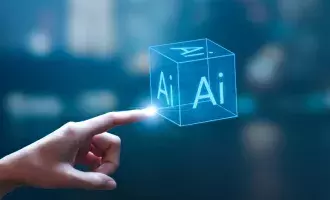AI is the great industrial shift of our time and, as a workforce development professional, it’s hard to know where to start. From identifying the skills your organisation needs to reimagining learning content creation and delivery, there are so many avenues you can explore.
It’s not surprising, then, that we have so many questions about it:
- How can I use AI today?
- What does this mean for the future of Learning and Development teams?
- Am I being left behind?
In our recent webinar, I explored these questions with three industry experts at the forefront of AI and learning:
- Dr Ashwin Mehta, Chief AI Strategist, LPI
- Paige Rinke, VP of People, Multiverse
- Matt Lowis, AI, Data & Technology Learning Lead, Capita
Content is the baseline
Poll 1 question from webinar - For which parts of the learning cycle are you already using AI? | |
|---|---|
Learning Needs Analysis | 19% |
Learning Design (learner pathways & scripting materials) | 23% |
Learning Development (building & testing content) | 20% |
Learning Scheduling | 5% |
Learning Delivery (AI as a learner-facing tool) | 12% |
Evaluating Success | 13% |
Other (add in the chat) | 8% |
One of the clearest insights from the session was that the primary AI usage for learning is in content design and development. Matt Lowis shared how Capita uses tools such as Synthesia, Powtoon, and Centrical to create and scale learning content.
However, as Paige Rinke explained, “content is the baseline”. AI is already doing so much to tackle content creation, the need for traditional learning design skills is not as great as it once was. You can see this in the share prices of content houses which, as Paige explained, have “gone down, because creating content is no longer a competitive advantage”.
Capita, like a growing number of organisations, is exploring with generative AI tools such as Microsoft’s CoPilot to offer classroom support. Such tools could enable diverse groups to reach a consistent skillset, with personalised coaching that meets them where they are.
The real risk? Doing the same things, just faster and cheaper
A powerful reflection came from one of our attendees, who paraphrased a point previously made by Dr Philippa Hardman that: “The biggest risk of AI is that it enables us to do what we already do, just faster and cheaper” This perfectly captures the danger in running headfirst at AI without a clear plan.
Our approach to workplace learning has never been perfect, whether it’s adequately mapping and tracking the skills we have in the organisation or showing true impact. Dr Ashwin Mehta explained, if we only implement AI to do what we do now, but faster, “that still has the trappings, the attributes, the shackles of the past”.
Ashwin believes that we should look to the true purpose of learning: helping people access the right information at the right time to drive performance. That means moving beyond ‘point solutions’ activities such as eLearning development or video creation, to ecosystem-level thinking, supported by emerging tools such as Agentic AI.
Imagining the next era of learning
Poll 2 question from webinar - For which parts of the traditional learning cycle are you actively exploring or seeking to use AI in future? | |
|---|---|
Learning Needs Analysis | 13% |
Learning Design (learner pathways & scripting materials) | 22% |
Learning Development (building & testing content) | 21% |
Learning Scheduling | 9% |
Learning Delivery (AI as a learner-facing tool) | 15% |
Analysing Success | 18% |
Other (add in the chat) | 3% |
AI moves at pace, and that means plenty more tools will appear to support us in developing our people. It might not be Abba Voyage, but Matt sees potential in holographic images for virtual teaching and wonders how this will shift the skills required by learning functions.
Whereas Ashwin sees potential in a world where AI tools provide “appropriate scaffolding” to create a deeper, more human-centred learning experiences.
AI adoption: Myths, realities and role of L&D
Using AI to deliver true workforce development relies on AI itself being adequately adopted by the organisation. In a world where tech evolves quicker than we can often handle, adoption is a space where learning functions need to support the wider organisation, not just themselves.
For both Multiverse and Capita, driving internal AI adoption is a priority. Both have found that the reality of adoption can be very different to typical stereotypes. Take the assumption that younger people are AI-advocates and older people are AI-adverse. Multiverse found that “younger employees with fewer than three years in the workforce [use] AI tools far less than their more experienced counterparts”.
Matt had similar findings within Capita, where ability and confidence wasn’t necessarily related to demographics. While some technical and non-technical specialists are eager to explore AI, others are held back by self-limiting beliefs and fear of what AI can do.
One of the keys to effective adoption? Digital literacy. Ashwin recommends following a similar approach and collating data to find out “why certain groups adopt AI tools more quickly or slowly and what barriers they face.” As Matt summarised, “not everybody’s digital literate, and they need to go at their own pace.”
Of course we’re behind, but why wouldn’t we be?
Poll 3 question from webinar - AI will significantly change the way my learning function is structured (e.g. different roles & skills requirements) in: | |
|---|---|
This year | 16% |
Next year | 13% |
2-3 years | 44% |
4-5 years | 16% |
I don't think it will change | 10% |
When it comes to AI, it’s easy to feel like you are falling behind. Some reports show People functions are lagging behind other departments in adopting AI. But, as Ashwin explained, why would we expect anything different, as he said:
“In a business, you have a primary value chain. Businesses take people, processors, technology, data, information [whatever the materials are], and process them and produce something that they sell for money… And then you have support departments that [are not in that primary value chain, but] enable those things.”
If you are not part of that value chain, you will adopt things less quickly than if you are in it. The only way to become part of that primary value chain is to show that your work creates direct business performance benefits. The answer lies in data. Without data that proves learning drives performance, L&D will continue to be sidelined when it comes to AI investment.
What’s the ROI of L&D in the age of AI?
At its core, AI is a tool for efficiency and cost-saving – and it raises tough questions about where value is being created by people. This poses an existential threat to a learning function, if they cannot adapt.
If the traditional role of L&D (turning SME insights into training content) is being automated, what are we investing in learning teams for? Ashwin thinks that this question could well lead to a fundamental restructuring of learning functions in the future, but exactly what that looks like is yet to be seen.
For Paige, this potential future shake-up is a “massive opportunity” for L&D to find a niche for themselves and provide value. For example, as various parts of the business implement AI to improve what they do, who is ensuring that everything that is learnt is shared across the business?
Advice from the experts
Finally, we asked each panellist to share the single biggest piece of advice for workforce development functions wrestling with AI. Here’s what they shared:
Networking: Network with other learning functions across industries and sectors, but also with AI itself. Push yourself to learn more and use generative tools to help you identify practical actions you can take in your organisation.
Relationship building: Grab the moment; engage your leadership teams, talk to them about their skill adoption challenges and then start building an integrated plan where you are the face of skills adoption in your organisation. This is a crucial moment for L&D to become part of organisational transformation.
People, process, technology: Make informed choices about the direction you take, thinking deeply about the extent to which you want our organisation to be human or tech focussed. It’s not a binary choice, but you can control the tipping point. Individually, focus on your passions and interests for the future and invest time in identifying where AI may play a part in that future. You have the power to carve your own destiny through the AI revolution.
Ready to reimagine your learning function?
Get in touch at learning@capita.com to explore how your organisation can lead the transformation of workforce development through the effective, human-focused use of AI.
Or find out how we can support your learning and development requirements:







